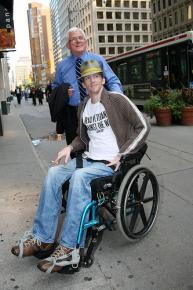War through the eyes of a vet
reviews a new film that shows one veteran's transformation into an opponent of war.
ON HIS fifth day of service in Iraq, Tomas Young was shot while riding in an unarmored truck through Sadr City, which left him paralyzed from the chest down at the age of 25.
A new film by Phil Donahue and Ellen Spiro, Body of War, chronicles Tomas's painful physical, emotional and political transformation from Top Gun fantasy warrior to active spokesman with the Iraq Veterans Against the War (IVAW).
Incensed by the corporate media's gung-ho coverage of the war in Iraq, Donahue and Spiro spent three years chronicling the odyssey of this one critically wounded soldier to expose the harsh reality behind the bipartisan rush to war. In its most powerful moments, Body of War allows the audience to witness the devastation of life after war for many of the 30,000 wounded so far.
As Tomas relates, most people see a man in a wheelchair and think he just can't walk, but watching him struggle to put on his pants, sit without falling over or passing out, insert a catheter he must wear, take morphine to kill the pain and grapple with his inability to have an erection fuels outrage at the way governmental indifference leaves the wounded to deal with these daunting burdens alone.
At one point, Tomas is rushed into the Veterans Affairs hospital for an emergency operation to deal with life-threatening lead levels in his blood--something he had to fight the bureaucracy to even test him for. He's left lying on a gurney afterward with fewer medical instructions than he received after getting his tattoo.
In a meeting with a paraplegic Vietnam veteran, he discovers that the less seriously wounded vet before him spent nearly two years in hospitals and rehabilitation to regain his strength and abilities, while Tomas was rushed through the system in less than three months, with no after-care or genuine rehabilitation.
The stress and superhuman patience and constant nursing he requires daily eats away at his new marriage to a young woman whose personal life is narrowed to non-stop caretaking for a man whom she sadly relates has only been able to have sex with her five times.
Scenes of Tomas attending his first antiwar march in September 2005, speaking before a church audience, joining Cindy Sheehan in Crawford, Texas, at her vigil to confront Bush that August, and becoming involved in the nascent IVAW are reminders of how a vocal and visible antiwar movement can draw in and give greater purpose to young vets like him--and his mother, who begins to rail against the imperial aims of the U.S. government.

She comments about the insanity of how young men are made to feel that only as soldiers can they be brave and honorable as she watches Tomas' younger brother head off to fight in Iraq. She'd be just as proud if he were working at Target for six bucks an hour.
THE FILM is seriously weakened by its adherence to Democratic Party politics and the invisibility of Iraqis as the primary victims of this war.
The backdrop to the film is the October 2002 "debate" and vote on the Iraq war in Congress. Scenes of Tomas going about his daily struggle and evolving politicization against the Bush regime and war are cut with familiar clips of both Republicans and Democrats repeating the lies about WMDs and Saddam-Hitler comparisons in the run-up to the war vote.
While Donahue and Spiro don't hesitate to show Democrats like Sen. Hillary Clinton enthusiastically chiming in for war, they transform the 23 senators who voted against it--in particular, the palsied Constitution-waving Sen. Robert Byrd (D.-W.Va.)--into heroes of the story. Byrd's passionate rhetoric against a rush to war and for the constitutional responsibility of Congress and not the president in declaring war aside, the political content of his and the other no-vote Democrats' appeals hardly amount to a principled antiwar stance.
Some are seen arguing for a United Nations or multilateral invasion, as if that would have made the destruction of Iraq and killing of 1.2 million people more acceptable. There is an underlying presumption that the Afghan war, given that country's supposed ties to al-Qaeda and 9-11, was justified. Despite five years of Democratic votes to fund the war--including the current debate, in which a Democratic-controlled Congress actually added $70 billion to Bush's requested $102 billion war-spending bill--the film portrays the war as Bush's boondoggle, not a bipartisan imperial project.
Byrd, who voted for the USA PATRIOT Act and has been a war hawk for most of his 50 years in Congress, is strangely pictured as the elder antiwar icon in this film. As the Senate Appropriations Committee chairman, Byrd is one of the architects of the Senate's current ploy to toss in a few domestic spending carrots to make this bloated war-funding bill appear palatable to voters in this election season.
In a Q&A with Donahue at the preview screening in Chicago, it became clear that, despite the filmmakers' good intentions, they blunted the message to avoid arguments for immediate withdrawal and didn't portray the war's horrifying impact on Iraqis because of their false presumptions that Americans are too right wing.
But the Gallup polls showing Bush's handling of the war and economy placing him at sub-Nixonian levels and the 80–95 million twenty-somethings who register record pro-union and ardently antiwar positions tell a different story.
Tomas Young's tale is a harrowing one that deserves a better conclusion than nudging viewers to go vote for Bush's pro-war collaborators in November.


